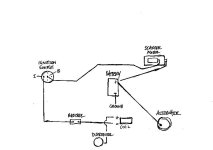OP
StevenPaul
Silver Member
- Joined
- Sep 9, 2005
- Messages
- 133
- Location
- Anderson County, SC
- Tractor
- John Deere 2010 (Kranky), JD 4500
ok, this is what I've configured so far; for a negative ground system, see also the attachment,
battery cable to (-) ground
battery cable (+) to starter motor, then
one wire from the alternator to (+) battery post,
coil wire (-) to coil resistor to I(ignition) prong on starter switch, and then finally, a wire from the starter motor to the B(battery) prong on the starter switch. Does this sound right?
All the other electrical will come later, the lights, gauges, etc.
and F is for fuel gauge
thanks again for the help,
Steve
battery cable to (-) ground
battery cable (+) to starter motor, then
one wire from the alternator to (+) battery post,
coil wire (-) to coil resistor to I(ignition) prong on starter switch, and then finally, a wire from the starter motor to the B(battery) prong on the starter switch. Does this sound right?
All the other electrical will come later, the lights, gauges, etc.
and F is for fuel gauge
thanks again for the help,
Steve

